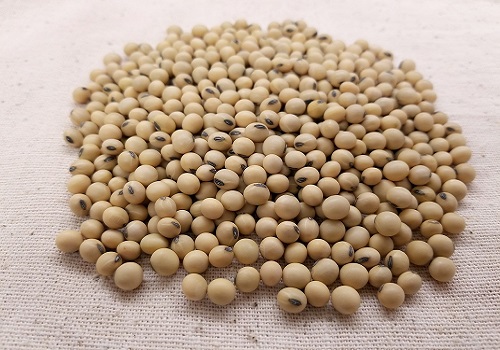Soybean Market Unleashed: What Lies Ahead in Prices? By Amit Gupta, Kedia Advisory

Below The Soybean Market Unleashed: What Lies Ahead in Prices? By Amit Gupta Kedia Advisory
Soybean, an important crop in world agriculture, plays an important role in meeting the global demand for vegetable oil and protein-rich animal feed. Soybean market dynamics are influenced by several factors, including production numbers, weather conditions, export-import trends, and global demand. As we study the latest data and market insights, we can better picture where the soybean market is headed. According to the latest data from the Ministry of Agriculture, India's sow area for the 2023 Kharif season stood at 125.13 million hectares on September 1, up 1.22% compared to last year's 123.91 million hectares. This increase reflects the continued commitment of Indian farmers to soybean cultivation. Soybean production numbers for the 2022-23 crop year (July-June) tell a remarkable story. Production reached a record high of 149.76 million MT, a sharp jump from last year's 129.87 million MT. This significant increase reflects the favourable conditions and farming practices that contributed to the bountiful harvest.
Soybean crops in states like Madhya Pradesh, Rajasthan and Maharashtra are now between 45 and 60 years old, according to the Soybean Processors Association of India (SOPA). The condition of these plants, pests and insects are under control. However, there is an urgent need for rain to sustain the crops; lack of it can cause significant damage. On the other hand, states like Telangana, Karnataka and Maharashtra have been late in spreading, leaving the plants in the vegetative stage. The extent of yield loss will depend on the recovery of rainfall in this area and it is too early to make an accurate prediction. One important factor in this equation is how the monsoon will behave in the next 45 days. Historically, El Niño years have experienced a monsoon rainfall deficit in September, with at least a 10% deficit in 70% of such cases. Thus, monsoon productivity remains a key variable in soybean market prospects. India's major agricultural states, including Maharashtra, Madhya Pradesh, Andhra Pradesh, Punjab and Gujarat, experienced a lack of rain during the southwest monsoon in August. This deficit, which ranges from 30% to 80% of the long-term average, is causing concern among farmers. Inadequate rainfall can reduce soil moisture and affect plant growth and yield. The link between monsoon failure and soybean production is clear. Prolonged dry spells can severely affect soybean plants during critical growth periods, resulting in reduced yield and bean size.
Understanding the global soybean market includes examining export and import trends. April-July 2023 data showed that India's total oilseed exports rose 28% to 1,591,348 MT compared to last year's 1,239,982 MT. In terms of soybean meal, India has lagged significantly in the international market, with exports at 420,820 MT compared to only 90,073 MT last year. This export recovery is an encouraging sign for Indian soybean producers. On the other hand, the import of vegetable oil in the first nine months of the oil year 2022-23 (from November 2022 to July 2023) increased by 23% compared to the same period last year and amounted to 12,254,953 MT. This upward trend is expected to continue and could set a new record of over 15.1 million MT.
To understand future soybean price trends, we need to look beyond India. The latest forecast for the 2023/24 season shows significant changes in global soybean production. Global soybean production is expected to increase by 8.9% compared to the previous season and reach 402.8 million MT. South American countries are ready for a significant increase in production. Brazil, the world's largest soybean producer, is expected to increase production by 4.5 % to 163 million MT. Argentina, another major player, is expected to increase by 92.0% to 48.0 million MT. Paraguay is also set to increase production by 10.5% and return to normal levels in the 2020/21 season, with an estimated output of 10 million MT. In contrast, the United States is expected to produce 114.5 million MT less, down 1.7% from the previous season. The decline could affect global soybean supply.
Export activity is expected to be led by Brazil, which is expected to export 96.5 million MT, up 2.7 % from last season. On the other hand, exports to the United States are expected to decrease, with an estimated amount of 49.7 million MT, representing a 7.8 % decrease in the final harvest. With good production, Argentina is expected to export 4.6 million MT, an increase of 17.9 % compared to the 2022/23 season. Major soybean importer China is expected to import 99 million MT, down 1% from last season. China's soybean imports are closely watched as they have a significant impact on global prices.
When we examine current market dynamics and future forecasts for soybeans, some key trends emerge:
Domestic Factors: Soybean production in India is on an upward trajectory, but its vulnerability to monsoon fluctuations underscores the importance of weather forecasting and preparedness for farmers.
Global dynamics: The global soybean market will witness an increase in production in South America, while the US is likely to see a slight decrease. The balance between supply and demand in this region will affect global prices.
Export-import trends: The recovery of soybean meal exports in India is a positive sign, but the rise in vegetable oil imports reflects changing consumption patterns.
Weather and Trade Uncertainty: The unpredictable nature of the monsoon and ongoing trade tensions between major players such as the US and China can introduce instability into the market.
Finally, while soybean production in India is increasing, market dynamics are heavily influenced by global factors such as weather conditions, international trade and production trends in major countries. Farmers and traders must monitor these variables to make informed decisions in a market that promises opportunities and challenges in the coming season.
Above views are of the author and not of the website kindly read disclaimer


.jpg)





















